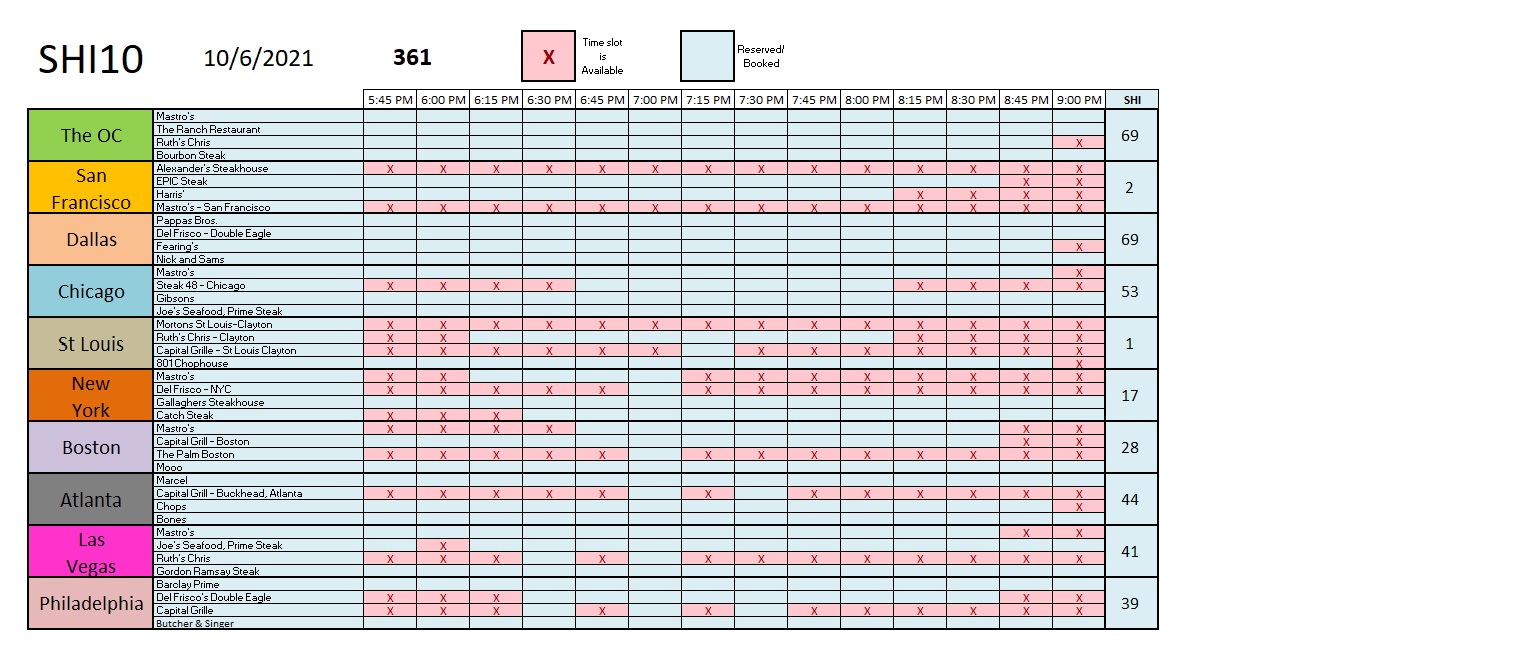SHI 10.6.21 – Change is the Only Constant

SHI 9.22.21 – I Gotta Buy Crypto!
September 22, 2021
SHI 10.13.21 – Coming Soon: A Housing Crash?
October 13, 2021And this is one of life’s big ironies, as about 2/3 of us dislike change. But like it or not, continuous change or mutation is the only constant. We all know it, but that makes it no easier to accept.
“
Change is inevitable.“
“Change is inevitable.“
What’s that? Too much philosophy for an economic blog? Bear with me, we’re heading in that direction.
Welcome to this week’s Steak House Index update.
If you are new to my blog, or you need a refresher on the SHI10, or its objective and methodology, I suggest you open and read the original BLOG: https://www.steakhouseindex.com/move-over-big-mac-index-here-comes-the-steak-house-index/
Why You Should Care: The US economy and US dollar are the bedrock of the world’s economy.
But is the US economy expanding or contracting?
The short answer? Expanding. By a staggering measure. In fact, during Q1 and Q2, annualized 2021 ‘real’ growth averaged about 6.4%. In nominal terms, our US economy averaged almost 12% growth — adding $1.245 trillion of economic activity during the first half of the year. The world’s annual GDP is expect to end 2021 near about $93 trillion. Annualized, America’s GDP settling in at almost $23 trillion by mid-year — still around 25% of all global GDP. Collectively, the US, the euro zone, and China still generate about 70% of the global economic output. These are your big players.
The objective of this blog is singular.
It attempts to predict the direction of our GDP ahead of official economic releases. Historically, ‘personal consumption expenditures,’ or PCE, has been the largest component of US GDP growth — typically about 2/3 of all GDP growth. In fact, the majority of all GDP increases (or declines) usually results from (increases or decreases in) consumer spending. Consumer spending is clearly a critical financial metric. In all likelihood, the most important financial metric. The Steak House Index focuses right here … on the “consumer spending” metric. I intend the SHI10 is to be predictive, anticipating where the economy is going – not where it’s been.
Taking action: Keep up with this weekly BLOG update. Not only will we cover the SHI and SHI10, but we’ll explore “fun” items of economic importance. Hopefully you find the discussion fun, too.
If the SHI10 index moves appreciably -– either showing massive improvement or significant declines –- indicating growing economic strength or a potential recession, we’ll discuss possible actions at that time.
The Blog:
About a century ago, Joseph Schumpeter was an influential economist. He popularized the somewhat oxymoronic economic concept of “Creative Destruction.”
According to Schumpeter’s theory, the “gale of creative destruction” describes the “process of industrial mutation that continuously revolutionizes the economic structure from within, incessantly destroying the old one, incessantly creating a new one.”
I just returned from vacation in Maui. On the flight over, high above the Pacific, I was trying to remember the last time I visited Maui. Eventually I settled on 5 years ago. Probably around 2016. That felt right.
After landing, leaving the airport, heading to our resort down south in beautiful Wailea, I was struck by an unexpected change in the landscape. Gone were the verdant fields of sugar cane. The cane fields, at first glance, appeared barren. But on closer observation, I saw small, baby plantlings; but, the sugar cane was gone. In all my prior trips to Maui, I had admired the miles and miles, tens of thousands of acres, of tall, majestic, wind-blown, sugar cane, seemingly denser than possible.
But not on this trip. Sadly, the cane was gone. All of it. I wondered if it was simply a circumstantial fluke in timing, of if something bigger was going on. It turned out something much bigger was definitely going on. I later learned that Hawaii’s last and largest sugarcane producer had closed its sugar operations on Maui after 134 years. 2016 — the year of my prior trip — was the final harvest. The plantations encompassed 36,000 acres. The owner says it’s dedicated to keeping all this land in central Maui in agriculture by leasing it to farmers with priority going to the prior employees, but many hundreds found themselves unemployed.
Why did the cane plantation close? For the usual reason: Money. The owner had been struggling for decades, it turn out, and reported operating losses of about $30 million in 2015. What changed to bring the century-old Maui institution to its knees? Foreign competition and automation. Brazil and India, China and Thailand, are all massive sugar producers today … and all can undercut the Maui prices, which, unfortunately, are highly labor intensive and old-school. As the global market evolved, Maui found that “doing it the same way we’ve been doing it for years” no longer worked. And so the business closed. Permanently.
Schumpeter would argue this is the natural state of affairs. He would argue that destruction must precede creation. And that all creation leads to destruction. Clearly he was not an overly happy, optimistic guy. 🙂
But happy or not, he’s probably more right than wrong. With time comes continuous change, mutation and evolution. It often happens so slowly we fail to notice the differences. I suspect many, if not most, of the Maui sugar workers were shocked by their company’s 2016 closure. Schumpeter would argue they should have expected it.
We cannot doubt the inevitability of change, even if we don’t recognize the signs. Consider this data, accumulated in 2019:
Only 52 US companies continuously remain in the ‘Fortune 500’ since 1955.
That’s right: 448 are no longer in the group. In 1955, American Motors, Brown Shoe Studebaker, Collins Radio, Detroit Steel, Zenith and National Sugar Refining were all in the F-500. Not today. In fact, many of the 448 are completely out of business. They are replaced by companies like Amazon, Facebook, eBay, Home Depot, Microsoft, Google, Netflix, and Target. In 1955, these companies weren’t even imagined.
Things change.

Which of this 52 is next for the scrap heap?
The bottom line: You don’t have to like change, but you had better keep an eye out for it. It is constant and inevitable. Are you ready?
It’s steak house time. After a 2-week absence, let’s see if reservation demand for Saturday remains robust:

It sure does. In fact, as you’ll see in the long-term grid below, there is little change in the SHI10, even as the individual 10 markets ebb and flow slightly. I do find the stark differences between the OC and San Francisco to be a bit puzzling. Expensive steak demand is exceedingly robust here in the OC, while 2 of the 4 restaurants we track in San Francisco are wide open. It’s rare to see Mastros with this many open tables. Perhaps the explanation lies in the public policy response to Delta — I believe the counties around San Francisco were far more restrictive during this most recent surge. That would seem to make the most sense. Here’s the long-term grid:

Fortunately for all of us, and for the economy, data suggests this latest wave of the pandemic is over. Is this the last wave? Is now the time that the epidemic becomes endemic? I believe the answer is yes. And I believe GDP here in the US, other developed nations, and emerging economies will all show meaningful signs of improvement going forward. The data supports this conclusion.
Simultaneously, of course, we face the headwinds of a residential real estate crash in China, the resulting contagion, and a US “debt crisis.” But I suspect these headwinds are only a slight summer breeze: China’s leaders must correct this problem or face public riots and US Senators and Congressmen must solve the debt ceiling crisis or face the loss of contributions from wealthy individuals and corporations. Yep, I’m a cynic. Pragmatic, but definitely a cynic. Neitzsche once commented, “Power corrupts, absolute power corrupts absolutely.” Hmmm … I guess he was a cynic too. 🙂
<:> Terry Liebman




